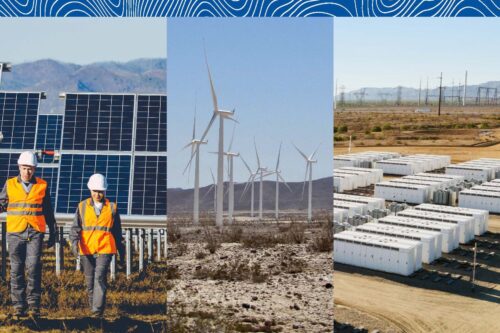
California state law sets a target of 100% clean electricity sales and economy-wide carbon neutrality by 2045, which requires developing roughly 7 to 10 GW of new clean resources every year. California hit that pace for the first time in 2024, but keeping it up will require fast-paced project delivery. The state’s Tracking Energy Development Task Force (a joint effort between the CPUC, CEC, CAISO, and GO-Biz to track and accelerate new energy projects in CA) flagged local permitting as one of the biggest hurdles to maintaining buildout.
To address that hurdle, the Governor’s Office of Business and Economic Development (GO-Biz) launched the Clean Energy Permitting Initiative, focused on the local land use permitting process. The aim is to provide practical support for counties and cities that permit utility-scale clean energy projects, so that these jurisdictions can streamline the review of projects while safeguarding environmental quality, public safety, and other community priorities. E3, alongside GHD, served as the consultants to GO-Biz. The Initiative resulted in a resource set developed with extensive stakeholder input: a Playbook that provides information and best practices for each component of the local permitting process, and a Toolkit of resources that can be used by planners to support permitting checklists, clean energy ordinance development, and community engagement. Our team contributed to the research, stakeholder outreach, synthesis, and drafting of these resources.

The Playbook is built on real-world pain points gathered through surveys, interviews, focus groups, webinars, and conference sessions. In total, the project team logged more than 300 touch points with local planners, developers, tribes, community-based organizations, and other stakeholders. Those inputs consistently highlighted staffing bandwidth constraints in planning departments, incomplete applications that trigger rework, community opposition that can lead to delays or rejections, and inconsistent or restrictive local ordinances. Health and safety questions around battery storage, particularly fire safety, also came up frequently.
The Toolkit is designed to meet those needs. It includes a standardized pre-application and application checklist that jurisdictions can tailor; model ordinance templates for solar, onshore wind, and battery energy storage; technology fact sheets for use in public engagement; and guidance for aligning community interests with clean energy project development. There is also dedicated guidance for permitting projects on tribal lands. These resources are aimed at making expectations clear up front, coordinating planning with building and fire officials, and garnering community support for locally sited projects.

Fire safety concerns for battery energy storage systems (BESS) were particularly noted as a hurdle to development. Several jurisdictions have adopted temporary moratoria while they develop regulations that ensure the safety of these systems in their communities. The Toolkit’s model BESS ordinance provides template language that jurisdictions can adapt to their zoning codes along with commentary on the trade-offs behind key choices. It clarifies fire safety requirements needed within a land use ordinance and underscores coordination with local fire officials. In presentations and stakeholder briefings, we emphasized that clear, consistent rules backed by the latest safety guidance reduce uncertainty for developers, enable deployment levels of BESS needed to meet the state’s climate targets, and give communities confidence that facilities will be sited and operated safely.
Aligning community interests with clean energy development was also frequently cited as a hurdle to project deployment. The Toolkit’s guide on community benefits outlines strategies for addressing this challenge while recognizing that each community has different needs. The guide describes the range of economic and environmental benefits that clean energy projects can provide to host communities and outlines options for coordination among community groups, local planners, and developers, such as Community Benefit Agreements. The guide also underscores the importance of communicating these benefits to stakeholders.

GO-Biz has posted the Draft Playbook and Toolkit for public review and is taking comments through November 21, 2025 via energyunit@gobiz.ca.gov. The Clean Energy Permitting Initiative site also links to recordings and slides from the state’s webinar series that walked through the materials. The final Playbook and Toolkit are scheduled for publication after the comment window closes.
In short, the project gives local planning authorities practical tools and a shared framework to move projects forward with confidence and consistency. These resources help ensure more projects can reach approval without compromising rigor, for the kind of steady progress California will need to meet its clean energy goals.
Reach out to lakshmi@ethree.com with any questions.


